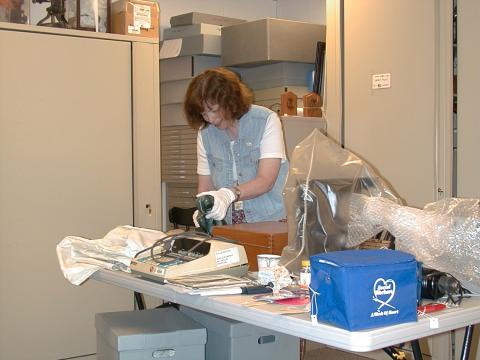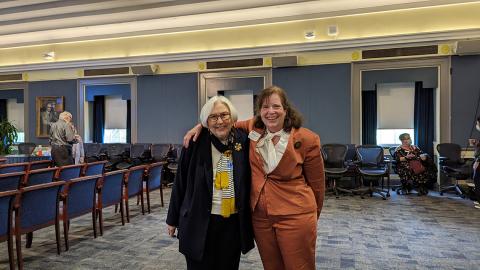Artifact Whisperer Departs
NIH History Office’s Founding Curator Lyons Retires
Call her the Dr. Doolittle for historical objects. If the legendary veterinarian’s chats with animals offer invaluable insight into their world, then Michele Lyons’s talks with scientific artifacts provide a similar glimpse into NIH’s rich origins and enterprise.

Associate director and founding curator of the Office of NIH History and Stetten Museum (ONHM), Lyons—who converses with inanimate items and translates their language for the rest of us—wrapped up her NIH career at the end of 2023.
A palm-size piece of polyurethane that became an artificial heart valve. A metallic watch fob, circa 1908, identifying Green River Whiskey as “the official whiskey of the U.S. Marine Hospital Service.” Artifacts of all sorts come to life in Lyons’s voice.
“Michele is blessed with a calling,” observed Dr. Kim Pelis, ONHM director, at the Dec. 11 lecture on important moments and themes in NIH history that Lyons presented as a parting gift to attendees. “Quite literally, objects call to her—and she listens,” Pelis continued. “Over a 30-year career of collecting objects on NIH history, of telling their stories and of following those objects and stories wherever they have led, she has transformed the History Office and NIH’s historical record alike.”
In 1988—when the museum was still just a gleam in its creators’ eyes—Lyons, a grad student in the museum studies program at George Washington University, came to NIH as a summer intern. ONHM Founding Director Dr. Victoria Harden immediately recognized a kindred soul. She hired Lyons as a contract curator in 1990 on an exhibit to commemorate the career of Dr. Scotty Pratt, “Computers in Medical Research.”
Lyons was called upon again in 1992, to curate an exhibit describing the work to find a non-addicting opiate by Dr. Kenner Rice’s lab. Harden recalled finally securing Lyons on an ongoing half-time contract in 1995, “essentially to do everything associated with the museum collection. She has overseen multiple moves of the instruments. She has catalogued most of the more than 4,000 objects.”
Before then, Lyons spent four years as a program coordinator at the U.S. Information Agency and two years before that as a visual information specialist in the exhibits service of the agency.
Over the succeeding years, Lyons would be courted and tempted by other history-related entities dangling bigger budgets and better salaries, but Harden was always able to coax the curator to stay, evoking the unique bond forged between story and storyteller.
“The Stetten Museum is your baby,” Harden reminded her every once in a while, appealing to Lyons’s deep connection to the thousands of photographs, manuals, documents, devices, instruments and exhibits she has collected, catalogued and curated in order to record, preserve and share the NIH narrative.
Inevitably, Lyons would decide to stay put—there were always new artifacts to unearth and vital conversations to chronicle.

“Sometimes the stories that the objects in our collection tell are pretty technical, scientific and medical discoveries,” Lyons explained during her lecture, “but they always have a human element. Because fundamentally, NIH history is the story of how people have worked together toward one end.”
At the end of the talk, Chris Wanjek, communications director for the NIH Office of Intramural Research, ONHM’s administrative home, turned the tables on Lyons. Employing a series of slides, he walked the audience through several objects that told the curator’s own story at NIH, including the hardhat in her office and her personal vehicle—both things she used over her career to collect and often manually move and transport donations to the museum.
“Unfortunately, we lose 30-some years of institutional memory when Michele retires, but we’re grateful to have had her,” he concluded. “Thank you, Michele.”
“I’ll miss meeting all of the people,” Lyons said. “I always wanted to be the president of the Royal Society, because you could learn all the cool new stuff about all the fields of study from all the people who were doing it. That’s pretty much what I ended up being—president of the Royal Society of NIH, at least. I will miss meeting all the different people and learning about all their work and their lives, because so much of it is so fascinating.”
Watch Lyons’s recent lecture, part of History & Context: The ONHM Seminar Series, at https://videocast.nih.gov/watch=53816.
